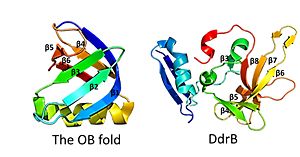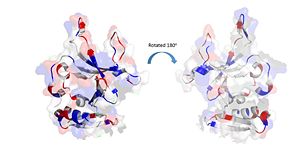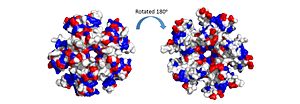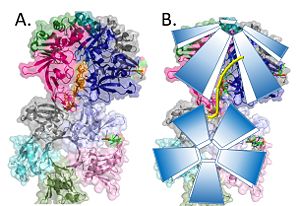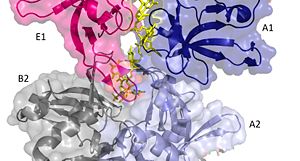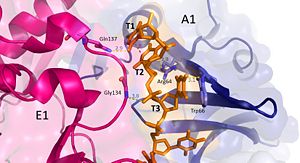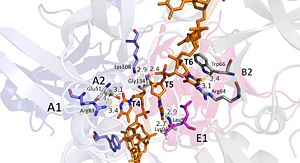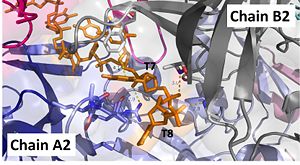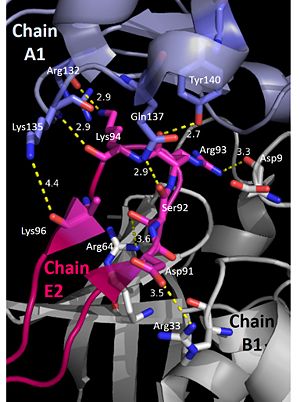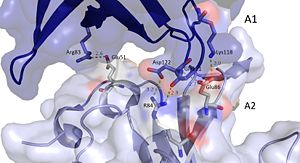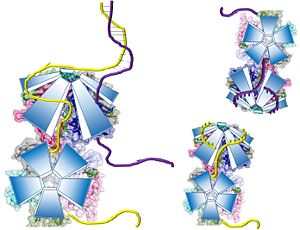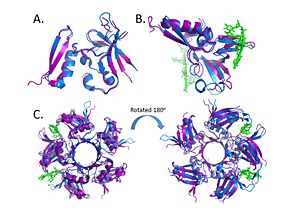Lauren Ferris/Sandbox 2
From Proteopedia
(Difference between revisions)
| (26 intermediate revisions not shown.) | |||
| Line 1: | Line 1: | ||
==DdrB== | ==DdrB== | ||
| - | <StructureSection load='4exw' size='450' side='right' caption=' | + | <StructureSection load='4exw' size='450' side='right' caption='[[4HQB]]' scene='57/578563/4exw_starting_molecule/2'> |
'''A Brief Description:''' | '''A Brief Description:''' | ||
| Line 9: | Line 9: | ||
==General Description== | ==General Description== | ||
| - | DdrB is a 20kDa protein that is found in the bacterial genus Deinococcus. While it is not limited to Deinococcus radiodurans, its functional relevance has been clearly noted in this species. Deinococcus radiodurans is known for being a resilient bacteria that can withstand 15,000 Gy of γ radiation. This effectively shatters the genome into hundreds of 20-30kB fragments. <ref>PMID: 17006450</ref> However, this bacteria is able to accurately repair its genome in a matter of hours and survive. This is an especially remarkable feat considering that the lethal dose of γ radiation in humans is 2-10 Gy. As a result, this finding has lead researchers to ask why Deinococcus radiodurans is able to survive such high levels of radiation? | + | DdrB is a 20kDa protein that is found in the bacterial genus Deinococcus. While it is not limited to Deinococcus radiodurans, its functional relevance has been clearly noted in this species. Deinococcus radiodurans is known for being a resilient bacteria that can withstand 15,000 Gy of γ radiation. This effectively shatters the genome into hundreds of 20-30kB fragments. <ref>PMID: 17006450</ref> However, this bacteria is able to accurately repair its genome in a matter of hours and survive. This is an especially remarkable feat considering that the lethal dose of γ radiation in humans is 2-10 Gy. As a result, this finding has lead researchers to ask why Deinococcus radiodurans is able to survive such high levels of radiation? Radiation still induces many double stranded breaks (which are a prime contributor to lethality in other organisms <ref>PMID: 19153654</ref>), so this ability has been attributed to several factors. One of these factors may include the genomic copy number as Deinococcus radiodurans contain 4-10 copies of their genome at any time.<ref>PMID:16261171</ref> However, the resistance to radiation-induced death has been primarily attributed to two components 1.) manganese dependent reactive oxygen species scavengers <ref>PMID: 17006450</ref><ref>PMID: 15459345</ref> and 2.) a unique repair pathway <ref>PMID: 17006450</ref><ref>PMID: 19303848</ref><ref>PMID: 15454524</ref>. |
| - | The repair pathway in Deinococcus radiodurans is thought to be a two step process. In the first part of repair, 5’ exonucleases generate long 3’ ssDNA extensions in the DNA fragments.<ref>PMID: 19303848</ref> The second part of the repair process involves the extensions being put together through RecA mediated homologous recombination or through single-strand annealing.<ref>PMID: 19303848</ref> These processes are also accompanied by an induction in the expression of a variety of proteins.<ref>PMID: 5438290</ref> DdrB is one of the proteins that becomes highly upregulated following extensive DNA damage. This has been confirmed through evaluation of mRNA transcripts<ref>PMID: 12651953</ref> and mass spectrometry proteomic analysis <ref>PMID: 21989019</ref>. These studies revealed that DdrB is one of the top five upregulated genes following radiation exposure. To be specific, DdrB expression increases by over 40 fold following exposure to 3,000 Gy of γ radiation.<ref>PMID: 15454524</ref> This is in sharp contrast to single stranded DNA binding proteins, which only have a minor increase in expression. | + | The repair pathway in Deinococcus radiodurans is thought to be a two step process. In the first part of repair, 5’ exonucleases generate long 3’ ssDNA extensions in the DNA fragments.<ref>PMID: 19303848</ref> The second part of the repair process involves the extensions being put together through RecA mediated homologous recombination or through single-strand annealing.<ref>PMID: 19303848</ref> These processes are also accompanied by an induction in the expression of a variety of proteins.<ref>PMID: 5438290</ref> DdrB is one of the proteins that becomes highly upregulated following extensive DNA damage. This has been confirmed through evaluation of mRNA transcripts<ref>PMID: 12651953</ref> and mass spectrometry proteomic analysis <ref>PMID: 21989019</ref>. These studies revealed that DdrB is one of the top five upregulated genes following radiation exposure. To be specific, DdrB expression increases by over 40 fold following exposure to 3,000 Gy of γ radiation.<ref>PMID: 15454524</ref> This is in sharp contrast to single stranded DNA binding proteins, which only have a minor increase in expression. For this and many other reasons, DdrB is thought to act as stress inducible equivalent of a single stranded DNA binding protein protecting and stabilizing any ssDNA that is present in the repair process.<ref>PMID: 15454524</ref> <ref>PMID: 19515845</ref> To further support the idea that DdrB has an essential role in the repair process of Deinococcus radiodurans, bacteria with no expression of DdrB experienced a 100 fold decrease in viability compared to the wild-type following exposure to 10,000 Gy of γ radiation. <ref>PMID: 15454524</ref> |
Subsequent studies have revealed that this protein is unique to the Deinococcus genus and varies in primary sequence length and composition depending upon the species. However, the protein structure and function remains similar. Electromobility shift assays have been used to further define DdrB function in terms of binding to nucleic acid.<ref>PMID: 20129942</ref> These experiments have shown that DdrB preferentially binds to ssDNA with low uM affinity. <ref>PMID: 20129942</ref> These studies also showed that DdrB has slight affinity for RNA and does not bind to double-stranded DNA. Even more recently, studies have shown that the function of DdrB is not limited to ssDNA binding. It has also been shown to promote the annealing of complementary oligonucleotides <ref>PMID: 20451472</ref> and surprisingly has been shown to suppress RecJ exonuclease activity <ref>PMID: 22301370</ref>, further implicating DdrB in the repair of fragmented genomic DNA. | Subsequent studies have revealed that this protein is unique to the Deinococcus genus and varies in primary sequence length and composition depending upon the species. However, the protein structure and function remains similar. Electromobility shift assays have been used to further define DdrB function in terms of binding to nucleic acid.<ref>PMID: 20129942</ref> These experiments have shown that DdrB preferentially binds to ssDNA with low uM affinity. <ref>PMID: 20129942</ref> These studies also showed that DdrB has slight affinity for RNA and does not bind to double-stranded DNA. Even more recently, studies have shown that the function of DdrB is not limited to ssDNA binding. It has also been shown to promote the annealing of complementary oligonucleotides <ref>PMID: 20451472</ref> and surprisingly has been shown to suppress RecJ exonuclease activity <ref>PMID: 22301370</ref>, further implicating DdrB in the repair of fragmented genomic DNA. | ||
| Line 25: | Line 25: | ||
'''The DdrB Core''' | '''The DdrB Core''' | ||
| - | This is followed by <scene name='57/578563/4exw_monomer_6b/1'>6 beta strands</scene>, which contain a solvent exposed face and another face that against the N-terminal motif. The beta sheets are anti-parallel and do not form an OB fold as determined by multiple servers iCOPS, DALI, 3D-BLAST, and MATRAS.<ref>PMID: 20129942</ref> At the time of this finding (2010), the lack of an OB fold was surprising, since all ssDNA binding proteins were thought to bind to DNA through an OB fold. The OB fold is two three-stranded anti-parallel β sheets that form a five stranded β barrel | + | [[Image:OB fold.jpg|300px|left|thumb|This figure highlights the differences between the classic OB fold found in single-stranded binding proteins and the novel structural features of DdrB. The OB fold is observed in the protein verotoxin-1, PDB code [[2XSC]] . DdrB is modeled from the PDB structure [[4HQB]]. This figure was generated using Pymol.]]This is followed by <scene name='57/578563/4exw_monomer_6b/1'>6 beta strands</scene>, which contain a solvent exposed face and another face that against the N-terminal motif. The beta sheets are anti-parallel and do not form an OB fold as determined by multiple servers iCOPS, DALI, 3D-BLAST, and MATRAS.<ref>PMID: 20129942</ref> At the time of this finding (2010), the lack of an OB fold was surprising, since all ssDNA binding proteins were thought to bind to DNA through an OB fold. The OB fold is two three-stranded anti-parallel β sheets that form a five stranded β barrel. The differences between the DdrB beta strands and those in the OB fold include the topology of the β strands. DdrB B strands form an up and down topology and are not as angled as the strands in the OB fold. Furthermore, monomeric DdrB β strands do not form a beta barrel. Additionally, DdrB has different connectivity, no conserved glycine, and no β bulge.<ref>PMID: 20129942</ref> |
| + | |||
| + | |||
| + | |||
| + | [[Image:electrostatics monomer.jpg|300px|left|thumb|The electrostatic charges in the DdrB monomer. Blue represents positive charges, while red represents negative charges. (PDB: [[4HQB]]). This figure was generated using Pymol.]] | ||
| + | Positively Charged amino acids reside in the solvent exposed beta strands, which may potentially enable the binding of ssDNA. | ||
| + | |||
| - | Positively Charged amino acids reside in the solvent exposed beta strands, which may potentially enable the binding of ssDNA. | ||
<scene name='57/578563/4exw_monomer_loops/1'>Two loops</scene> that link beta sheet 6 to sheet 7 and beta sheet 7 to sheet 8 contain flexible regions with poor order as determined by limited to no density in the crystal structure. This finding suggests that these loops are intrinsically disordered.<ref>PMID: 20129942</ref> | <scene name='57/578563/4exw_monomer_loops/1'>Two loops</scene> that link beta sheet 6 to sheet 7 and beta sheet 7 to sheet 8 contain flexible regions with poor order as determined by limited to no density in the crystal structure. This finding suggests that these loops are intrinsically disordered.<ref>PMID: 20129942</ref> | ||
| + | |||
| + | |||
| + | |||
| + | |||
| + | |||
| + | |||
| + | |||
'''The C-terminal Domain''' | '''The C-terminal Domain''' | ||
The C-terminal domain also contains regions with predicted intrinsic disorder.<ref>PMID: 20129942</ref> The PSIpred server predicts that the last 35 residues of Deinococcus geothermalis are disordered. This prediction is supported by the solved crystal structure as the last 51 residues could not be determined. While, the structure of the C-terminal end is not known, it may still be of interest. A BLAST search revealed an 83 amino acid protein in Deinococcus geothermalis with 72% similarity and 62% identity to the disordered region of the C-terminus.<ref>PMID: 20129942</ref> However, the function of this protein remains unknown. One hypothesis is that this region may mediate protein-protein interactions. Single stranded binding proteins also have disordered C-termini and contain negatively charged residues that mediate protein-protein interactions. As DdrB contains several conserved negatively charged residues it is thought that the C-terminus of this protein could also mediate protein-protein interactions.<ref>PMID: 20129942</ref> However, this hypothesis may be debated as the C-terminus was not needed for radioresistance in Deinococcus radiodurans.<ref>PMID: 21968057</ref> | The C-terminal domain also contains regions with predicted intrinsic disorder.<ref>PMID: 20129942</ref> The PSIpred server predicts that the last 35 residues of Deinococcus geothermalis are disordered. This prediction is supported by the solved crystal structure as the last 51 residues could not be determined. While, the structure of the C-terminal end is not known, it may still be of interest. A BLAST search revealed an 83 amino acid protein in Deinococcus geothermalis with 72% similarity and 62% identity to the disordered region of the C-terminus.<ref>PMID: 20129942</ref> However, the function of this protein remains unknown. One hypothesis is that this region may mediate protein-protein interactions. Single stranded binding proteins also have disordered C-termini and contain negatively charged residues that mediate protein-protein interactions. As DdrB contains several conserved negatively charged residues it is thought that the C-terminus of this protein could also mediate protein-protein interactions.<ref>PMID: 20129942</ref> However, this hypothesis may be debated as the C-terminus was not needed for radioresistance in Deinococcus radiodurans.<ref>PMID: 21968057</ref> | ||
| + | |||
| + | |||
===DdrB Pentamer=== | ===DdrB Pentamer=== | ||
| - | The monomeric units of DdrB collectively form a <scene name='57/578563/4exw_pentamer/1'>pentameric ring </scene>with a 10 A pore in the center of this structure.<ref>PMID: 20129942</ref> Other DNA binding proteins can thread DNA through a central pore, however this seems highly unlikely in the case of DdrB. The pore size appears too small (would need to be 14-40A) and has a net negative charge making it highly unfavorable for DNA interactions.<ref>PMID: 20129942</ref> The beta-beta-alpha motif at the N-terminus of the monomer facilitates the formation of this <scene name='57/578563/Start_molecule_and_bbar/1'> pore </scene> as the beta sheets of the N-terminal beta-beta-alpha motif form a 10 stranded <scene name='57/578563/B_barrel/1'>anti-parallel B-barrel</scene>. This | + | The monomeric units of DdrB collectively form a <scene name='57/578563/4exw_pentamer/1'>pentameric ring </scene>with a 10 A pore in the center of this structure.<ref>PMID: 20129942</ref> Other DNA binding proteins can thread DNA through a central pore, however this seems highly unlikely in the case of DdrB. The pore size appears too small (would need to be 14-40A) and has a net negative charge making it highly unfavorable for DNA interactions.<ref>PMID: 20129942</ref> The beta-beta-alpha motif at the N-terminus of the monomer facilitates the formation of this <scene name='57/578563/Start_molecule_and_bbar/1'> pore </scene> as the beta sheets of the N-terminal beta-beta-alpha motif form a 10 stranded <scene name='57/578563/B_barrel/1'>anti-parallel B-barrel</scene>. <ref>PMID: 20129942</ref> |
| + | |||
| + | [[Image:electrostatics pentamer.jpg|300px|left|thumb|The electrostatic charges in the DdrB pentamer. Blue represents positive charges, while red represents negative charges. A positive “track” around the top of the pentamer may enable ssDNA binding to one side of the pentamer (left image). (PDB: [[4HQB]]). This figure was generated using Pymol.]] | ||
| + | The pentamer also contains a positive residue track on one side of the pentamer. These residues are thought to facilitate ssDNA binding and DdrB functionality. <ref>PMID: 20129942</ref> | ||
| + | |||
| + | |||
| + | |||
| + | |||
| + | |||
| + | |||
| + | |||
| + | |||
| + | |||
| + | |||
| + | |||
| + | |||
| - | The pentamer also contains a positive residue track on one side of the pentamer. These residues facilitate ssDNA binding and DdrB functionality. <ref>PMID: 20129942</ref> | ||
| - | |||
==Structural features that relate to function== | ==Structural features that relate to function== | ||
| - | Recently, a structure for Deinococcus radiodurans in complex with ssDNA has been solved.<ref>PMID: 23975200 </ref> The structure revealed that ssDNA bind in two clefts between three subunits. One 4 base pair strand of DT bound in the cleft between E and A, while the other 4 base pair strand of DT bound between A and B. Interestingly, when symmetry was applied to the crystal the dT strands appeared continuous. <ref>PMID: 23975200 </ref> | + | [[Image:Pentamer-pentamer.jpg|300px|left|thumb|Model of the pentamer-pentamer structure. (PDB: [[4HQB]]) This figure was generated using Pymol.]] |
| + | Recently, a <scene name='57/578563/4hqb_start3/1'>structure</scene> for Deinococcus radiodurans in complex with ssDNA has been solved.<ref>PMID: 23975200 </ref> The structure revealed that ssDNA bind in two clefts between three subunits. One 4 base pair strand of DT bound in the cleft between E and A, while the other 4 base pair strand of DT bound between A and B. Interestingly, when symmetry was applied to the crystal the dT strands appeared continuous. <ref>PMID: 23975200 </ref> | ||
| + | |||
| + | |||
| + | |||
| + | |||
| + | |||
| + | |||
| + | |||
| + | |||
| + | |||
| + | |||
| + | [[Image:DNA channel.jpg|300px|left|thumb|Two pentamers associate forming a channel for the ssDNA to thread through. (PDB: [[4HQB]]) This figure was generated using Pymol.]] | ||
The crystal structure also determined that the pentameric ring binds to another pentameric ring. Given the continuous chain formed by the DT strands it appears that the chain passes through the channel formed by subunits A and E in one pentamer. (which will now be referred to as A1 and E1). To pass through the channel in the second pentamer between A and B (now A2 and B2). In this direction the DNA strand runs in the 5’ to 3’ direction.<ref>PMID: 23975200 </ref> | The crystal structure also determined that the pentameric ring binds to another pentameric ring. Given the continuous chain formed by the DT strands it appears that the chain passes through the channel formed by subunits A and E in one pentamer. (which will now be referred to as A1 and E1). To pass through the channel in the second pentamer between A and B (now A2 and B2). In this direction the DNA strand runs in the 5’ to 3’ direction.<ref>PMID: 23975200 </ref> | ||
| + | |||
| + | |||
| + | |||
| + | |||
| + | |||
| + | |||
| + | |||
| + | |||
| + | |||
| + | |||
| + | |||
| + | |||
| + | |||
The interactions between DdrB and the DNA strand include: | The interactions between DdrB and the DNA strand include: | ||
| + | [[Image:t1-3.jpg|300px|left|thumb|Interactions between DdrB and T1-T3. (PDB: [[4HQB]]) This figure was generated using Pymol.]] | ||
'''Nucleotides 1, 2, 3 (T1, T2, and T3 respectively):''' Interact with Chains A1 and E1 | '''Nucleotides 1, 2, 3 (T1, T2, and T3 respectively):''' Interact with Chains A1 and E1 | ||
| - | -T1 hydrogen bonds to Q137 of chain E1. | ||
| - | -T1 and T2 base stack and form a cation pi interaction with R64 of the β3 strand in chain A1. | ||
| - | -T3 hydrogen bonds to R64 of chain A1, forms a pi-pi interaction with W66 from chain A. T3 also forms hydrogen bonds with the 5’ phosphate and amino group of G134 in chain E1. <ref>PMID: 23975200 </ref> | ||
| + | T1 hydrogen bonds to Gln137 of chain E1. T1 and T2 base stack and form a cation pi interaction with R64 of the β3 strand in chain A1. | ||
| + | T3 hydrogen bonds to Arg64 of chain A1, forms a pi-pi interaction with Trp66 from chain A. T3 also forms hydrogen bonds with the 5’ phosphate and amino group of Gly134 in chain E1. <ref>PMID: 23975200 </ref> | ||
| + | |||
| + | |||
| + | |||
| + | |||
| + | |||
| + | |||
| + | |||
| + | |||
| + | |||
| + | [[Image:DNA T4-6.jpg|300px|left|thumb|Interactions between DdrB and T4-T6. (PDB: [[4HQB]]) This figure was generated using Pymol.]] | ||
'''Nucleotides 4, 5, 6 (T4, T5, and T6 respectively):''' Bridge the Pentamers | '''Nucleotides 4, 5, 6 (T4, T5, and T6 respectively):''' Bridge the Pentamers | ||
| - | + | T4 stabilized by electrostatic interactions with Arg83 from chain A and Glu51 from chain A. T5 forms hydrogen bonds with Lys96 of Chain E and forms van der Waal contacts with Lys135 chain A. (There are also van der wall interactions between the hydrophobic patch of the B6’-B7’ hairpin (Leu95 and Leu97) and electrostatic interactions between Lys108 from the chain A loop between B7 and 8 and the 5’ phosphate)T6 forms a hydrogen bond with Arg64 of chain B, van der Waal interactions with Leu95 and Leu97, and pi-pi interactions with Trp66 of chain B. The 5’ phosphate of T6 hydrogen bonds with the amino group of Gly134 of chain A. <ref>PMID: 23975200 </ref> | |
| - | + | ||
| - | (There are also van der wall interactions between the hydrophobic patch of the B6’-B7’ hairpin ( | + | |
| - | + | ||
| - | + | ||
| + | |||
| + | |||
| + | |||
| + | |||
| + | [[Image:t7-8.jpg|300px|left|thumb|Interactions between DdrB and T7 and T8. (PDB: [[4HQB]]) This figure was generated using Pymol.]]'''Nucleotides 7 and 8 (T7 and T8 respectively):''' Interact with Chains A2 and B2 | ||
| + | The 5’ phosphate of T7 hydrogen bonds with Lys94 of chain A and Arg132 of chain A. T7 forms pi-pi interactions with Trp66 of chain B and forms a hydrogen bond with Lys96. T8 is stabilized by a hydrophobic patch on the B6’-B7’ hairpin (Val90 chain A. Phosphate groups of T8 stabilized through hydrogen bonding with Ala81, His80, and Gly106. <ref>PMID: 23975200 </ref> | ||
| + | |||
| + | |||
| + | |||
| + | |||
| + | |||
| + | |||
| + | |||
| + | |||
| - | '''Nucleotides 7 and 8 (T7 and T8 respectively):''' Interact with Chains A2 and B2 | ||
| - | -The 5’ phosphate of T7 hydrogen bonds with K94 of chain A and R132 of chain A. | ||
| - | -T7 forms pi-pi interactions with W66 of chain B and forms a hydrogen bond with K96. | ||
| - | -T8 is stabilized by a hydrophobic patch on the B6’-B7’ hairpin (V90 chain A) | ||
| - | -Phosphate groups of T8 stabilized through hydrogen bonding with A81, H80, and G106. <ref>PMID: 23975200 </ref> | ||
| Line 70: | Line 141: | ||
| - | It should be noted that the quarternary structure enables the formation of a ssDNA channel. This structure forms independent of ssDNA binding and is stabilized by a variety of factors. The major interaction involve the interactions between the B6’-B7’ hairpin of chain E1 with the cleft from chains A2 and B2. Stabilization factors include electrostatic interactions and hydrogen bonding. Three essential salt bridges have also been identified in stabilizing this structure | + | It should be noted that the quarternary structure enables the formation of a ssDNA channel. This structure forms independent of ssDNA binding and is stabilized by a variety of factors. The major interaction involve the interactions between the B6’-B7’ hairpin of chain E1 with the cleft from chains A2 and B2. Stabilization factors include electrostatic interactions and hydrogen bonding. Three essential salt bridges have also been identified in stabilizing this structure. Two key residues in these interactions are Glu51 and Arg83. <ref>PMID: 23975200 </ref> |
| - | [[Image: | + | [[Image:E loop.jpg|300px|left|thumb|The pentamer-pentamer interactions are stabilized by interactions involving the hairpin of chain E. (PDB:[[4HQB]]). This figure was generated using Pymol.]] |
| + | [[Image:A chains.jpg|300px|right|thumb|The pentamer-pentamer interface is also stabilized by salt bridges and hydrogen bonds between the A chainds. (PDB:[[4HQB]]) This figure was generated using Pymol.]] | ||
| + | |||
| + | |||
| + | |||
| + | |||
| + | |||
| + | |||
| + | |||
| + | |||
| + | |||
| + | |||
| + | |||
| + | |||
| + | |||
| + | |||
| + | |||
| + | |||
| + | |||
| + | |||
| + | |||
| + | |||
| + | |||
| + | |||
| + | |||
| + | |||
| + | |||
| + | |||
| + | |||
| + | |||
| + | |||
| + | |||
| + | |||
| + | |||
| + | |||
| + | |||
| + | |||
| + | |||
| + | |||
| + | |||
| + | |||
| + | |||
| + | It has been hypothesized that the most recent crystal structure of DdrB and ssDNA does not fully depict the ssDNA/DdrB interaction. <ref>PMID: 23975200 </ref> This idea is thought because the positively charged track (see above) on the surface of one side of the DdrB protein is not utilized in this crystal structure. It is possible that the DNA binds to this positive track and then proceeds through the DNA channel formed by the pentamers. This is not unreasonable, as the crystal structure for uracil-DNA glycosylase failed to reveal an additional binding surface – that was later detected. <ref>PMID: 22492624 </ref> Given the new-found role of DdrB in facilitating ssDNA strand annealing, it did not seem likely that the ssDNA channel revealed in the crystal structure could support this function. Therefore, DdrB mutants were generated that altered the positive track and ssDNA binding was tested. This experiment showed that the mutants could not bind ssDNA as well, suggesting that this surface area is involved in ssDNA binding. <ref>PMID: 23975200 </ref> | ||
| + | |||
| + | |||
| + | |||
| + | [[Image:models.jpg|300px|left|thumb|Potential Mechanisms for DdrB mediated ssDNA annealing as proposed by Sugiman-Marangos et al. (PDB: [[4HQB]] This figure was generated using Pymol.]] | ||
| + | |||
| + | |||
| + | Studies have suggested that the binding stoichiometry between ssDNA and DdrB is about 41 to 56 nucleotides per pentamer. <ref>PMID:21968057</ref> Given this finding and what is known about the protein from the crystal structures, it would seem reasonable that the ssDNA would associate with both the DNA channel and positive track on the surface of DdrB. The simplest reconciliation of these factors is displayed on the left side of the figure, where two ssDNA strands associate with DdrB via different clefts in the top pentamer and annealing occurs as a result of the positioning of two ssDNA strands. <ref>PMID: 23975200</ref> Another "simple" model proposed, is that the nucleotide bases are positioned away from the pentamer when a ssDNA molecule binds to DdrB <ref>PMID: 23975200</ref>. (As nucleotide bases have adapted this turned out structure in Rad52 <ref>PMID: 12370410</ref>) Annealing would then be driven by the association of two pentamer-pentamers. In either case, thermodynamics would drive the formation of the duplex.<ref>PMID: 23975200</ref> | ||
| + | |||
| + | It is also possible that more complex ssDNA/DdrB conformations are required for functionality. | ||
| + | |||
| + | |||
| + | |||
| + | |||
| - | It has been hypothesized that the most recent crystal structure of DdrB and ssDNA does not fully depict the ssDNA/DdrB interaction. <ref>PMID: 23975200 </ref> This idea is thought because the positively charged track (see above) on the surface of one side of the DdrB protein is not utilized in this crystal structure. It is possible that the DNA binds to this positive track and then proceed through the DNA channel formed by the pentamers. This is not unreasonable, as the crystal structure for uracil-DNA glycosylase failed to reveal an additional binding surface – that was later detected. Given the new-found role of DdrB in facilitating ssDNA strand annealing, it did not seem likely that the ssDNA channel revealed in the crystal structure could support this function. Therefore, DdrB mutants with an altered positive track were generated and tested. This experiment showed that the mutants could not bind ssDNA as well, suggesting that this surface area is involved in ssDNA binding. <ref>PMID: 23975200 </ref> | ||
==Related Proteins== | ==Related Proteins== | ||
| + | |||
| + | [[Image:Alignment.jpg|300px|left|thumb| Alignment of the crystal structures of Deinococcus radiodurans and Deinococcus geothermalis. (A.) Alignment of chains c, (B.) Alignment of Chains a with DNA, (C.) Alignment of the pentamer. (PDB: [[4EXW]] and [[4HQB]]) This figure was generated using Pymol.]] | ||
DdrB is unique to the genus Deinococcus and shares very few similarities with other ssDNA binding proteins. As mentioned above, many ssDNA binding proteins function through an OB fold. However, this fold is missing in DdrB and Ddrb present a novel ssDNA binding mechanism. | DdrB is unique to the genus Deinococcus and shares very few similarities with other ssDNA binding proteins. As mentioned above, many ssDNA binding proteins function through an OB fold. However, this fold is missing in DdrB and Ddrb present a novel ssDNA binding mechanism. | ||
| - | Within the Deinococcus genus, DdrB is relatively conserved between species. The crystal structures of Deinococcus radiodurans and Deinococcus geothermalis are quite similar. However, there are some differences in the regions connecting B6-B7 and B7-B8. This difference may be due to difference in stability, the DNA present in the Deinococcus radiodurans structure may provide stabilize this part of the structure leading to the discrepancy.<ref>PMID: 23975200 </ref> | + | Within the Deinococcus genus, DdrB is relatively conserved between species. A uniprot alignment between the primary structures of Deinococcus radiodurans and Deinococcus geothermalis showed that there was a 70% identity between the proteins. The crystal structures of Deinococcus radiodurans and Deinococcus geothermalis are also quite similar. However, there are some differences in the regions connecting B6-B7 and B7-B8. This difference may be due to difference in stability, the DNA present in the Deinococcus radiodurans structure may provide stabilize this part of the structure leading to the discrepancy.<ref>PMID: 23975200 </ref> |
| - | + | There may also be similarities between DdrB and another Deinococcus DNA binding protein DdrA - however, more research is needed on the latter protein before any conclusions can be made. <ref>PMID: 23975200 </ref> | |
| - | + | ||
| - | <scene name='57/578563/4hqb_start2/1'>4HQB start</scene> | ||
| - | <scene name='57/578563/4hqb_ab_nuc_interacts/1'>ab nucleic interact</scene> | ||
| - | <scene name='57/578563/4exw_monomer_helix_hydro/2'>TextToBeDisplayed</scene> | ||
Current revision
DdrB
| |||||||||||
